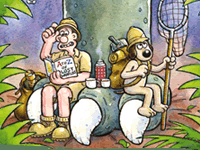|
|

A statue of Sherlock Holmes in Picardy Place stands close to the house (number 11) where his creator, Arthur Conan Doyle, was born.
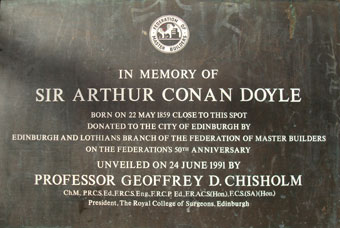
The plaque on the Picardy Place statue (Edinburgh UNESCO City of Literature Trust 2008).
Other addresses where the author lived during his time in Edinburgh include Tower Bank House in Portobello, 3 Sciennes Place, Liberton Bank (next to the Conan Doyle Medical Centre), 2 Argyle Park Terrace, 23 George Square (there is a plaque here to commemorate his occupancy) and 15 Lonsdale Terrace. His first school was Newington Academy in Salisbury Place.
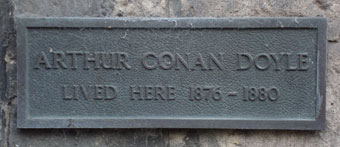
The Conan Doyle plaque in George Square (Edinburgh UNESCO City of Literature Trust 2008).
His first published story, 'The Mystery of Sasassa Valley', was based on Leith Walk in Edinburgh and the volcanic rocks of Salisbury Crags in Holyrood Park inspired the plateau of The Lost World (there is a visitor centre in the park where you can find out about the area's geological and natural wonders).
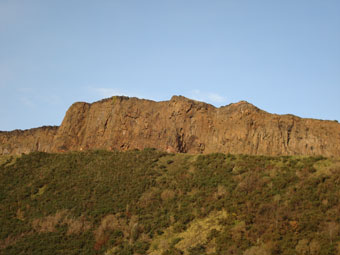
Salisbury Crags, Edinburgh, inspiration for the plateau of Conan Doyle's The Lost World (Edinburgh UNESCO City of Literature Trust 2008).
Surgeon's Hall Pathology Museum on Nicolson Street is home to Conan Doyle and Joseph Bell: the real Sherlock Holmes exhibition. It features letters, artworks, objects and film, drawing together the many and varied connections in the author's work. The exhibition focuses especially on Conan Doyle's relationship to Joseph Bell who later became President of the Royal College of Surgeons of Edinburgh and whose analytical mind and keen powers of observation led Conan Doyle to write 'It is most certainly to you that I owe Sherlock Holmes'.
Conan Doyle and Darwin both studied medicine at the University of Edinburgh. The website Capital Collections provides images of the city from the nineteenth century when Darwin and Conan Doyle studied there. Conan Doyle's tutor, Professor William Rutherford, Professor of Physiology, is thought to have inspired the character of Professor Challenger in The Lost World. You can see a statue of Rutherford in Surgeon's Hall.

The Conan Doyle pub at York Place, opposite Picardy Place (Edinburgh UNESCO City of Literature Trust 2008).
While Darwin was at the university he lived with his brother Erasmus at 11 Lothian Street (marked with a plaque), a few doors away from the home of John Edmonstone, the freed slave who taught him taxidermy. Having little interest in his medical studies, Darwin made regular visits to the Natural History Museum where the curator, William Macgillivray, encouraged him to take observational notes during his nature walks. He also became friends with the Edinburgh-born zoologist Robert Grant who gave him guidance on studying marine invertebrates and would have been aware of the work of the Edinburgh-born geologist James Hutton.
The university's Biological Sciences and Chemistry Collections are housed in the Darwin Library. Edinburgh is also home to the John Murray Archive in the National Library of Scotland. It was John Murray which published Darwin's On the Origin of Species and many of his other books. The library's own collection, at George IV Bridge, contains 60 Conan Doyle letters, the original manuscript of 'The Adventure of the Illustrious Client', which was the first story in The Casebook of Sherlock Holmes (1927) and the short story manuscript 'The Haunted Grange of Goresthorpe' (published posthumously in 2001).
Other places of interest in the city include the National Museum of Scotland, which has exhibits of fossils and dinosaurs, Our Dynamic Earth, an interactive exhibit telling the unique story about our planet's past, present and future, and the Royal Botanical Garden.
Allan Foster leads the Booklovers' Tour, where you can learn more about Edinburgh's literary greats, including Conan Doyle.
|
|

Go to One Book – One Edinburgh for further details and regular updates about what’s happening in the city during the Lost World Read 2009.
|
| Edinburgh is UNESCO's first City of Literature. Go to the literature hub to find out more. |
| Edinburgh UNESCO City of Literature Trust has produced a guide highlighting all the locations linked to Conan Doyle in the city. |
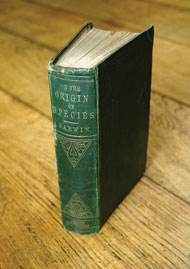
First edition of On the Origin of Species published by John Murray in 1859, the year Conan Doyle was born (University of Bristol Library, Special Collections).
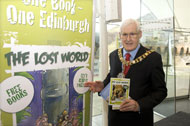
Edinburgh's Lord Provost supports the reading campaign.
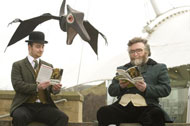
Ed Malone and Professor Challenger in the City of Literature on launch day.
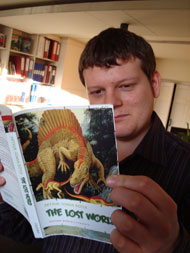
Danny gets stuck into the reading.
|
|
|
